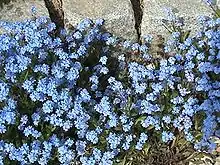Myosotis
Myosotis (/ˌmaɪ.əˈsoʊtɪs/ MY-ə-SOH-tiss[2]) is a genus of flowering plants in the family Boraginaceae. The name comes from the Ancient Greek μυοσωτίς "mouse's ear", which the foliage is thought to resemble.[3] In the northern hemisphere they are colloquially denominated forget-me-nots[4] or scorpion grasses. The colloquial name "forget-me-not" was calqued from the German Vergissmeinnicht and first used in English in AD 1398 through King Henry IV of England.[5] Similar names and variations are found in many languages. Myosotis alpestris is the official flower of Alaska[6] and Dalsland, Sweden. Plants of the genus are commonly confused with Chatham Islands' forget-me-nots which belong to the related genus Myosotidium.
| Myosotis | |
|---|---|
 | |
| Myosotis arvensis | |
| Scientific classification | |
| Kingdom: | Plantae |
| Clade: | Tracheophytes |
| Clade: | Angiosperms |
| Clade: | Eudicots |
| Clade: | Asterids |
| Order: | Boraginales |
| Family: | Boraginaceae |
| Subfamily: | Boraginoideae |
| Genus: | Myosotis L. |
| Type species | |
| Myosotis scorpioides L. [1] | |
Distribution
More than 500 species names have been recorded, but only 74 species are presently accepted. The remainder are either synonyms of presently accepted or proposed names.[7] The genus is largely restricted to western Eurasia, with approximately 60 confirmed species, and New Zealand with approximately 40 confirmed species. A few species occur elsewhere including North America, South America, and Papua New Guinea.[4] Despite this, Myosotis species are now common throughout temperate latitudes because of the introduction of cultivars and alien species. Many happen to be popular in horticulture. They prefer moist habitats—in locales where they are not native, they frequently escape to wetlands and riverbanks. Only those native to the Northern hemisphere are colloquially denominated "forget-me-nots".
One or two European species, especially Myosotis sylvatica, the "woodland" forget-me-nots, were introduced into most of the temperate regions of Europe, Asia, and the Americas.
Morphology
Myosotis species have pentamerous actinomorphic flowers with 5 sepals and petals.[3] Flowers are typically 1 cm in diameter or less; flatly faced; colored blue, pink, white, or yellow with yellow centers; and born on scorpioid cymes. They typically flower in spring or soon after the melting of snow in alpine ecosystems. They are annual or perennial. The foliage is alternate, and their roots are generally diffuse.
The seeds are contained in small, tulip-shaped pods along the stem to the flower. The pods attach to clothing when brushed against and eventually fall off, leaving the small seed within the pod to germinate elsewhere. Seeds can be collected by placing a sheet of paper under stems and shaking the seed pods onto the paper.
Myosotis scorpioides is also colloquially denominated scorpion grass because of the spiraling curvature of its inflorescence.[3]
Ecology
Myosotis are food for the larvae of some Lepidoptera species including the setaceous Hebrew character. Many of the species in New Zealand are threatened.[8]
Distribution and phylogeny
The genus was originally described by Carl Linnaeus. The type species is Myosotis scorpioides. Myosotis species are distributed in temperate areas of the northern hemisphere and southernhemisphere. The genus has two centres of species diversity in Europe and New Zealand. Genetic analysis indicates that the genus originated in the northern hemisphere, and that species native to New Zealand, Australia, New Guinea and South America form a lineage of closely related species that are likely derived from a single dispersal event to the southern hemisphere.[4][9]
Taxonomy
There are 89 species, subspecies, and varieties of Myosotis in World Flora Online,[10] of which 42 species are endemic to New Zealand.[11] The full list of species includes:
- Myosotis abyssinica Boiss. & Reut.
- Myosotis afropalustris C.H. Wright
- Myosotis albiflora Banks & Sol. ex Hook.f.
- Myosotis albosericea Hook.f.
- Myosotis alpestris F.W.Schmidt (alpine forget-me-not)
- Myosotis alpina Lapeyr.
- Myosotis amabilis Cheeseman
- Myosotis ambigens (Bég.) Grau
- Myosotis angustata Cheeseman
- Myosotis antarctica Hook.f.
- Myosotis arnoldii L.B.Moore
- Myosotis arvensis (L.) Hill (field forget-me-not)
- Myosotis asiatica (Vestergr. ex Hultén) Schischk. & Serg. (Asiatic forget-me-not)
- Myosotis azorica H.C.Watson (Azores forget-me-not)
- Myosotis balbisiana Jord.
- Myosotis baltica Sam. ex Lindm.
- Myosotis bothriospermoides Kitag
- Myosotis brevis de Lange & Barkla
- Myosotis brockiei L.B.Moore & M.J.A.Simpson
- Myosotis bryonoma Meudt, Prebble & Thorsen
- Myosotis cadmea Kitag
- Myosotis capitata Hook.f.
- Myosotis caespitosa Schultz (tufted forget-me-not)
- Myosotis chaffeyorum Lehnebach
- Myosotis cheesemanii Petrie
- Myosotis colensoi (Kirk) J.F.Macbr.
- Myosotis concinna Cheeseman
- Myosotis decumbens Host
- Myosotis discolor Pers (changing forget-me-not)
- Myosotis densiflora C. Koch
- Myosotis eximia Petrie
- Myosotis explanata Cheeseman
- Myosotis forsteri Lehm.
- Myosotis glabrescens L.B.Moore
- Myosotis glauca (G.Simpson & J.S.Thomson) de Lange & Barkla
- Myosotis goyenii Petrie
- Myosotis incrassata Guss.
- Myosotis krylovii Serg.
- Myosotis laeta Cheeseman
- Myosotis laingii Cheeseman
- Myosotis lamottiana (Braun-Blanq. ex Chass.) Grau
- Myosotis latifolia Poir. (broadleaf forget-me-not)
- Myosotis laxa Lehm. (tufted forget-me-not or bay forget-me-not)
- Myosotis lithospermifolia Hornem.
- Myosotis lyallii Hook.f.
- Myosotis lytteltonensis (Laing & A.Wall) de Lange
- Myosotis macrantha (Hook.f.) Benth. & Hook.f.
- Myosotis macrosperma (largeseed forget-me-not)
- Myosotis matthewsii L.B.Moore
- Myosotis monroi (Monro's forget-me-not)
- Myosotis mooreana Lehnebach
- Myosotis nemorosa Besser
- Myosotis oreophila Petrie
- Myosotis pansa (L.B.Moore) Meudt, Prebble, R.J.Stanley & Thorsen
- Myosotis pansa subsp. pansa (L.B.Moore) Meudt, Prebble, R.J.Stanley & Thorsen subsp. pansa (Waitakere forget-me-not)
- Myosotis pansa subsp. praeceps (L.B.Moore) Meudt, Prebble, R.J.Stanley & Thorsen subsp. pansa
- Myosotis petiolata Hook.f.
- Myosotis pottsiana (L.B.Moore) Meudt, Prebble, R.J.Stanley & Thorsen
- Myosotis pulvinaris Hook.f.
- Myosotis pygmaea Colenso
- Myosotis ramosissima Rochel (early forget-me-not)
- Myosotis rakiura L.B.Moore
- Myosotis retrorsa Meudt, Prebble & Hindmarsh-Walls
- Myosotis rivularis (Vestergr.) A.P. Khokhr
- Myosotis sachalinensis Popov
- Myosotis saxosa Hook.f.
- Myosotis scorpioides L. (true forget-me-not)
- Myosotis secunda (creeping forget-me-not)
- Myosotis sicula Guss. (Jersey forget-me-not)
- Myosotis sparsiflora J.C.Mikan ex Pohl
- Myosotis spatulata G.Forst.
- Myosotis speluncicola Schott ex Boiss
- Myosotis stenophylla Knaf
- Myosotis stricta Link ex Roem. & Schult
- Myosotis strigulosa Rchb.
- Myosotis suavis Petrie
- Myosotis sylvatica Ehrh. ex Hoffm (wood forget-me-not)
- Myosotis tenericaulis Petrie
- Myosotis traversii Hook.f.
- Myosotis umbrosa Meudt, Prebble & Thorsen
- Myosotis uniflora Hook.f.
- Myosotis venosa Colenso
- Myosotis verna Nutt. (spring forget-me-not)
Gallery

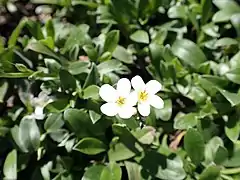
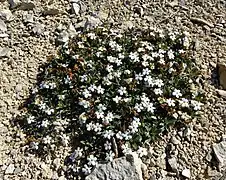 Myosotis colensoi
Myosotis colensoi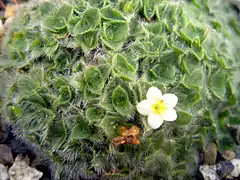 Myosotis pulvinaris
Myosotis pulvinaris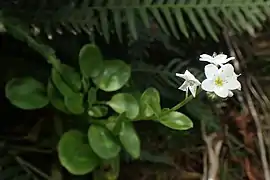 Myosotis pansa
Myosotis pansa
Symbolism
The small blue forget-me-not flower was first used by the Grand Lodge Zur Sonne, in 1926, as a Masonic emblem at the annual convention in Bremen, Germany. In 1938, a forget-me-not badge—made by the same factory as the Masonic badge—was chosen for the annual Nazi Party Winterhilfswerk, the annual charity drive of the National Socialist People's Welfare, the welfare branch of the Nazi party. This coincidence enabled Freemasons to wear the forget-me-not badge as a secret sign of membership.[12][13]
After World War II, the forget-me-not flower was used again as a Masonic emblem in 1948 at the first Annual Convention of the United Grand Lodges of Germany. The badge is now worn in the coat lapel by Freemasons around the world to remember all who suffered in the name of Freemasonry, especially those during the Nazi era.[14]
The flower is also used as a symbol of remembrance by the people of Newfoundland and Labrador. It is used to commemorate those from the province who were killed in the First World War, and worn around July 1.
It is also used in Germany to commemorate the fallen soldiers of the world wars in a similar manner to the use of remembrance poppies in the UK.
The flower is also the symbol for the Armenian Genocide's 100th anniversary.
In The Netherlands, the forget-me-not has become a symbol for Alzheimer Nederland, a foundation advocating for people suffering from dementia.
References
- Lehnebach, C. (2012). "Lectotypification of three species of forget-me-nots (Myosotis: Boraginaceae) from Australasia". Tuhinga. 23: 17–28.
- "Myosotis". Oxford English Dictionary (Online ed.). Oxford University Press. (Subscription or participating institution membership required.)
- Chisholm, Hugh, ed. (1911). . Encyclopædia Britannica. 10 (11th ed.). Cambridge University Press. p. 663.
- Winkworth, Richard C.; Grau, Jürke; Robertson, Alastair W.; Lockhart, Peter J. (2002). "The Origins and Evolution of the Genus Myosotis L. (Boraginaceae)" (PDF). Molecular Phylogenetics and Evolution. 24 (2): 180–93. doi:10.1016/S1055-7903(02)00210-5. PMID 12144755.
- Sanders, Jack (2003). The Secrets of Wildflowers: A Delightful Feast of Little-Known Facts, Folklore, and History. Globe Pequot. ISBN 1-58574-668-1.
- "Alaska Kid's Corner". State of Alaska. Retrieved 2016-05-21.
- "Species in Myosotis". The Plant List. Royal Botanic Gardens, Kew. Retrieved 2015-03-28.
- Lehnebach, Carlos A. (2012-08-21). "Two new species of forget-me-nots (Myosotis, Boraginaceae) from New Zealand". PhytoKeys. 16 (16): 53–64. doi:10.3897/phytokeys.16.3602. PMC 3492931. PMID 23233811.
- Meudt, Heidi M.; Prebble, Jessica M.; Lehnebach, Carlos A. (2014-11-07). "Native New Zealand forget-me-nots (Myosotis, Boraginaceae) comprise a Pleistocene species radiation with very low genetic divergence". Plant Systematics and Evolution. 301 (5): 1455–1471. doi:10.1007/s00606-014-1166-x. ISSN 0378-2697. S2CID 14686750.
- "Home". www.worldfloraonline.org. Retrieved 2019-11-24.
- "Flora of New Zealand | Taxon Profile | Myosotis". www.nzflora.info.
- "Das Vergissmeinnicht-Abzeichen und die Freimaurerei". www.internetloge.de (in German). Archived from the original on 2019-05-02. Retrieved 2019-07-21.
- Bernheim, Alain. ""The Blue Forget-Me-Not": Another Side of the Story". Pietre-Stones Review of Freemasonry. Archived from the original on 2019-01-30. Retrieved 2019-07-21.
- "The Story Behind Forget Me Not Emblem!". Masonic Network Blog. 2009-12-11. Archived from the original on 2019-04-04. Retrieved 2019-07-21.
